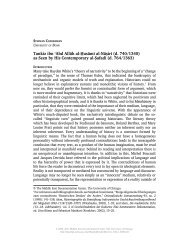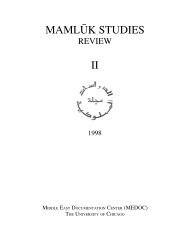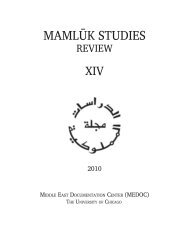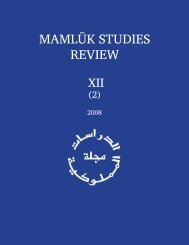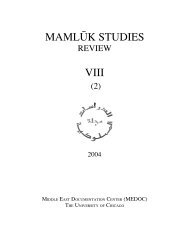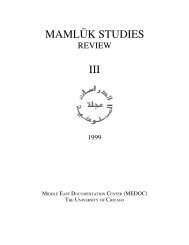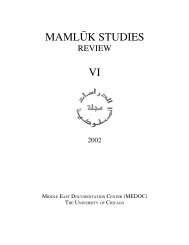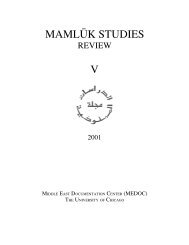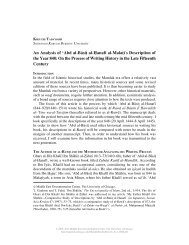Mamluk Studies Review Vol. IV (2000)
Mamluk Studies Review Vol. IV (2000)
Mamluk Studies Review Vol. IV (2000)
Create successful ePaper yourself
Turn your PDF publications into a flip-book with our unique Google optimized e-Paper software.
30 ROBERT IRWIN, UNDER WESTERN EYES<br />
Receuil, though nothing ever came of this.) Quatremère had inherited his teacher's<br />
passion for and mastery of philology and the inordinately lengthy footnotes to<br />
Histoire des sultans mamlouks are tremendous displays of erudition on the meanings<br />
of words for military offices, gypsies, polo balls, wardrobe-masters, heraldry, and<br />
much else. Those annotations were later heavily drawn upon by Dozy for his<br />
dictionary of post-classical Arabic. They also provided a starting point for later<br />
researches into institutions by Gaudefroy-Demombynes and Ayalon. They were<br />
industrious giants in those days and among Quatremère's other publications was<br />
an edition of Ibn Khaldu≠n's Muqaddimah, Prolégomènes d'Ibn Khaldoun: texte<br />
arabe. 9 As we shall see, Ibn Khaldu≠n was to do as much as anyone in shaping<br />
western historians' perceptions of the <strong>Mamluk</strong>s.<br />
A student of Quatremère, Gustave Weil (1808-89) was the first scholar to<br />
provide a sustained, detailed, and referenced history of the <strong>Mamluk</strong>s. Those were<br />
the days when one did not need a historical training to write history and Weil's<br />
wide range of publications included a translation of Alf Laylah wa-Laylah. His<br />
history of the <strong>Mamluk</strong> period, Geschichte des Abbasidenchalifats in Egypten, 10<br />
was a sequel to Geschichte der Chalifen, 11 and, like its precursor, it uncritically<br />
reproduced the material provided by sources such as al-Suyu≠t¸| and Ibn Iya≠s. 12<br />
William Muir's The Mameluke or Slave Dynasty of Egypt 1260-1517 13 acknowledged<br />
a heavy debt to Weil's ferreting among obscure manuscripts on the continent.<br />
Apart from Weil, Muir's three main sources were al-Maqr|z|, Ibn Taghr|bird| and<br />
Ibn Iya≠s. Muir was a devout Christian and, as he made plain in his preface and<br />
introduction, the <strong>Mamluk</strong>s' chief importance was as adversaries of the Crusaders,<br />
as the <strong>Mamluk</strong>s "were finally able to crush the expiring efforts of that great<br />
armament of misguided Christianity." A few exceptional figures apart, Muir was<br />
not favorably impressed by the <strong>Mamluk</strong>s: "But the vast majority with an almost<br />
incredible indifference to human life, were treacherous and bloodthirsty, and<br />
betrayed, especially in the later days of the Dynasty, a diabolic resort to poison<br />
and the rack, the lash, the halter and assassination such as makes the blood run<br />
cold to think of. . . ." 14<br />
9<br />
Paris, 1858. On the life and work of Quatremère, see Johann Fück, Die arabischen Studien in<br />
Europa bis in den Anfang des 20. Jahrhunderts (Leipzig, 1955), 152-53.<br />
10<br />
Stuttgart, 1860-62.<br />
11<br />
Mannheim, 1846-51.<br />
12<br />
Fück, Die arabischen Studien, 175-76; D.M. Dunlop, "Some Remarks on Weil's History of the<br />
Caliphs," in Bernard Lewis and P. M. Holt, eds., Historians of the Middle East (London, 1962),<br />
315-29.<br />
13<br />
London, 1896.<br />
14 Ibid., xii, 220.<br />
© <strong>2000</strong>, 2012 Middle East Documentation Center, The University of Chicago.<br />
http://mamluk.uchicago.edu/<strong>Mamluk</strong><strong>Studies</strong><strong>Review</strong>_<strong>IV</strong>_<strong>2000</strong>.pdf



